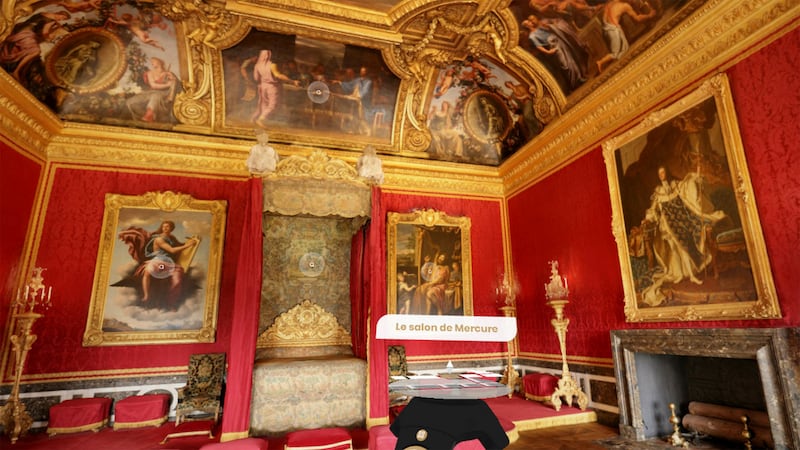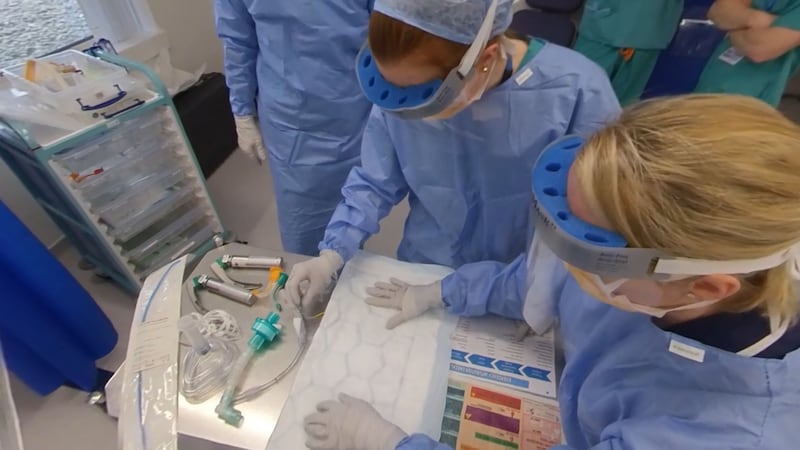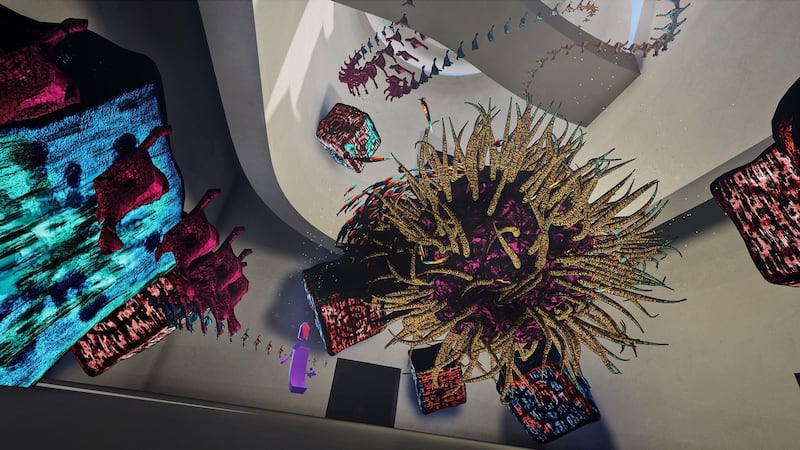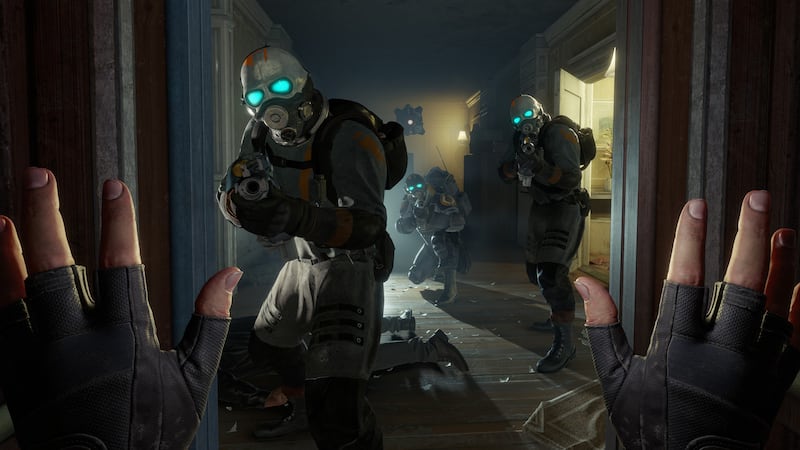The Covid-19 crisis has reinforced our sense of the importance of digital devices in our lives. After a backlash in recent years over personal data breaches, disinformation and other ethically dubious practices by Big Tech, users are popping their heads back over their social media parapets, returning to their timelines on Facebook and Twitter to stay in touch. Others are being introduced for the first time to chat services such as Hangouts and Zoom. Collaboration platforms Slack and Microsoft Teams are now key elements of many businesses. And videogaming is seeing a surge, with even Second Life getting a second life.
But one thing doesn’t seem to change. Our devices are stuck in the same old paradigm: a flat screen containing windows of text and images. In the VR community some call this “pancake vision”.

Virtual reality (VR) – donning a headset to replace your physical environment with a digital one – has been around for a while. Its initial popularity in the 1990s may have faded, but the promise of VR lingered on. Were these alternative realities designed to bring consciousness-expanding benefits, or just an opportunity to escape a reality that might not be offering what you need?
If you think you've tried VR because you used a Google Cardboard or experienced a short VR demo, you'd be wrong. The technology is maturing. Newer VR systems such as the remarkable Oculus Quest bring an advanced experience for a price range roughly the same as buying a PlayStation (with no telly required). In the Quest's beginner's tutorial, take a few steps towards a paper airplane on a floating cube. You are invited to use your own hands to reach down, pick it up and throw it. You watch it soar and disappear over a digital horizon. This simple action triggers a feeling of "presence" as your brain accepts this digital world as its primary reality.
True VR for the masses has arrived – and it’s not flat – it’s spatial.
Interaction happens in much the same way as the real <br/> world – with your body
Sharing a VR space with another user is an experience hard to describe. It’s like hanging with someone in the real world. Suddenly, your brain can read microscopic body language cues unavailable through Zoom or Hangouts. You can throw a ball to each other. You can fly weightlessly together. You can high five.
This is a surprisingly physical experience. Interaction happens in much the same way as the real world – with your body. Exciting gaming and narrative experiences become possible, along with strengthened embodied cognition, which results in higher knowledge retention. You learn faster in VR (“I know kung fu” – Neo).
I've explored these ideas in a short Ulysses adaptation, dug a bit deeper by completing a MSc specialising in games design, worked in R&D as an engineer and VR designer in Accenture's design group, Fjord. I'm now working on how the music industry could adapt to VR with Rotor, which is especially pertinent given the current situation with live shows. I've found more common ground between these projects and immersive theatre and cognitive psychology than with other forms I've worked in.
I believe this is a fundamentally transformative technology for art, business, entertainment, learning, collaboration and social interaction. Drawing on work from Stanford’s Reality lab to create evidence-based approaches to the experiences, I’ve seen outcomes that are so positive for people and businesses that, even with the challenging weirdness of wearing a headset, I thought it was only a matter of time until VR went mainstream.
However, businesses can be slow to adopt any new technology and there was always a chance that the current VR wave could fail just like it did in the 1990s.

Covid-19 highlights many shortcomings in our society but also reminds us how some technologies can be hugely beneficial. 3D printers that might have been gathering dust are now being used to manufacture spare parts and PPE. Last week, the NHS instructed a VR company to retrain 15,000 nurses, doctors, cleaners and porters in the fight against coronavirus. That company has already trained 14,000 health workers in the US and expects to train another 50,000 within the next fortnight. Suddenly, it seems VR has become an essential tool.
At home I have found VR a remarkable way to fight loneliness and isolation. I may be stuck indoors but I can visit the Museum of Alternative Realities with my isolated friend in London. I can go to City 17 and play the exceptional new chapter of the Half Life videogame franchise (VR only). I can play Beatsaber, burning the same amount of calories as in a game of tennis. I’ve travelled the palace of Versailles using Google’s astoundingly detailed full 3D scan for VR (if they had only done it for Notre Dame). I don’t feel the need to go there for real now.
<a class="search" href='javascript:window.parent.actionEventData({$contentId:"7.1213540", $action:"view", $target:"work"})' polopoly:contentid="7.1213540" polopoly:searchtag="tag_person">John Carmack</a>, a legendary engineer in the development of the Oculus Quest, said that was why it was a "moral imperative" to bring VR to the masses
Reducing travel’s carbon footprint has been a long-standing objective for VR researchers. Some applications virtualise the social aspects of sharing a workspace. Sharing the same room can mean a lot. Even a quick game of virtual table tennis with a colleague can break up the day and give you a slice of shared physical human interaction you might otherwise miss (even if your real office might not have enough space for a table).
Beyond our current predicament, maybe even on a normal day you can't easily leave your home or you live in cramped conditions. VR might not be a perfect solution, but it can objectively improve lives. John Carmack, a legendary engineer in the development of the Oculus Quest, said that was why it was a "moral imperative" to bring VR to the masses.

Next-generation headsets could start appearing over the next year; standards like WebXR, Web Assembly and decentralised splatforms on the blockchain hold the potential to transform the web into a virtual reality of itself, the long-promised "metaverse" coined by Neal Stephenson in his novel Snowcrash.
Imagine exploring Wikipedia with your colleague or classmates, its content visualised as a reality instead of just text and 2D images. What if all the students missing school right now could pop into a VR classroom, and go on VR field trips? The fact is that even these are pedestrian predictions; the concept of reality design will most likely open up ideas that are hard for us to yet grasp.
During the early wave of the pandemic in China, I mentioned on Twitter that of all the locked down citizens in China, the VR headset owners must be a little happier. Tim Maughen, author of the excellent sci fi novel Infinite Detail, a warning about diminishing privacy, replied: "Not as happy as Mark Zuckerberg. "
It is true that VR headsets and hand-tracking controllers are potential data mining devices. VR creates datasets that could infer the next level of highly accurate predictive behavioural analytics. GDPR protects EU citizens but it is difficult to know what kind of data is being collected elsewhere. Privacy and personal data rights are a key part of the VR phenomenon. and enterprises which engage with the technology must be aware of the risks.
Even so, I still think people with the VR headsets are probably a little happier.
Which headset
Decent headsets are in demand and regularly come in and out of stock. If you want a high-end experience for gaming and detailed museums, you’ll need a PC. Here’s a short guide if you are considering taking the plunge.
Oculus Quest
The go-to headset for the VR newbie. No PC required, no wires, runs an advanced experience all on the headset. Considering it runs on similar processors to a mid-range mobile device, this thing is a miracle. It has a growing library of content such as VR fave Beatsaber and Star Wars: Vader Immortal (wielding the lightsaber is magic). The killer feature – plug it into a PC, and it runs PC-powered content.
Oculus Go
Lightweight, low cost and basic, this headset proves popular for media consumption such as watching Netflix in a virtual cinema with friends. Also popular for training applications that utilise 360 video.
Valve's Index
An Index setup not only costs you €1,000, you also need a PC worth about the same to use it. Valve designed it in line with the development of Half Life: Alyx, much like Nintendo designed its systems with Mario and Zelda in mind (Alyx, however, is available on all other PC platforms). This design approach resulted in a unique system that's considered the enthusiast's choice for high-end VR.
Oculus Rift S
The Rift is a bit of a classic at this point. For PC power VR that's better than Quest, and access to all the high-end experiences, this is still a great headset and much cheaper than the Index.
PSVR
If you have a PlayStation Pro and are VR curious, PSVR has a decent library and there are a few great games which are PSVR only such as Astrobot, one of the best games on any VR platform.
Windows Mixed Reality Headsets
This is where you might pick up a deal. PC-powered headsets are made by many different companies using licensed Microsoft IP. You can pick one up quite cheaply but make sure to read the reviews of the one you are purchasing carefully.
Things to do in VR?
Exercise: Beatsaber, Dance Central and Sparc are among many excellent games you can quickly run up a sweat playing. Check The VR Institute of Health and Exercise for calorie-burn ratings of each app. Don't forget your sweatband.

Play: Triple A gaming has arrived to PC-powered VR, with Half Life Alyx and RPG Asgard's Wrath receiving perfect review scores from popular gaming outlets. Lower powered gaming on systems like Quest remain remarkable due to the unique nature of the interactions and run games such as Beatsaver, Star Wars Vader Immortal, Moss and Pavlov. Physically throwing a clip across a battlefield to your teammate when she runs out of ammo is a gaming experience consoles can't replicate.
The Arts: Experiential content is booming in VR. Palace of Versailles could replace a costly real world visit and sites usually closed to visitors are available such as the Egyptian tomb of Queen Nefertari and the Chauvet Cave. Tribeca Film Festival has moved much of its VR programme to online and free this year, and creative tools such as Quill provide ways of designing in 3D space that feel nothing short of magical.
Meet: Cross platform applications such as Rec Room and VR Chat are free, super popular and invite users on any device to jump in and share the fun too. Play games, watch content and create together in otherwise impossible spaces. Facebook is due to launch its mega social VR project Horizon this year.
Work: VR Conferences and Meetups offer the social experience of sharing a presentation with peers. I've shuffled out of a VR auditorium into a breakout space and continued conversations, networking and learning in a similar way that you would at a regular conference. Plus, they're a fraction of the cost to both stage and attend.

















